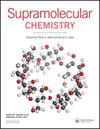Calixarene-Based lead receptors: an NMR, DFT and X-Ray synergetic approach
IF 2.6
4区 化学
Q3 CHEMISTRY, MULTIDISCIPLINARY
引用次数: 1
Abstract
ABSTRACT The conformational changes of the homooxa adamantyl ketones 1 and 2, as well as of the calix[4]arene analogue derivative 3, all in the cone conformation, upon Pb2+ complexation were investigated by 1H, 13C, 207Pb NMR and proton spin-lattice relaxation times (T 1) experiments. The X-ray crystal structures of ketones 1 and 3 were determined. The inclusion of an acetonitrile molecule in the hydrophobic cavity of the ligands was observed in the solid state. In solution, inclusion was observed only in the case of Pb2+ ⊂ ketone 3 complex. DFT calculations were also performed to complement the NMR conformational analysis and to bring further insights to the cation complexation. The data confirmed the formation of 1:1 complexes between Pb2+ and the ligands, and that the cation is located inside the cavity defined by the phenoxy and carbonyl oxygen atoms. In general, the ligand conformations became closer to a regular cone upon complexation, with the binding models found for the three ketones through the NMR studies corroborated by the DFT calculations.杯芳烃为基础的铅受体:核磁共振,DFT和x射线协同方法
采用1H、13C、207Pb核磁共振和质子自旋-晶格弛豫时间(t1)实验研究了Pb2+络合作用下具有锥形构象的同形亚甲酮1和2以及杯[4]芳烃类似衍生物3的构象变化。测定了酮1和酮3的x射线晶体结构。在固体状态下,在配体的疏水腔中观察到乙腈分子的包涵。在溶液中,只观察到Pb2+∧酮3配合物的包合。DFT计算也进行了补充核磁共振构象分析,并带来进一步的见解阳离子络合。数据证实Pb2+与配体之间形成1:1的配合物,并且阳离子位于由苯氧和羰基氧原子定义的空腔内。总的来说,配体构象在络合后变得更接近于一个规则的锥体,通过核磁共振研究发现的三种酮的结合模型得到了DFT计算的证实。
本文章由计算机程序翻译,如有差异,请以英文原文为准。
求助全文
约1分钟内获得全文
求助全文
来源期刊

Supramolecular Chemistry
化学-化学综合
CiteScore
3.60
自引率
3.00%
发文量
5
审稿时长
2.7 months
期刊介绍:
Supramolecular Chemistry welcomes manuscripts from the fields and sub-disciplines related to supramolecular chemistry and non-covalent interactions. From host-guest chemistry, self-assembly and systems chemistry, through materials chemistry and biochemical systems, we interpret supramolecular chemistry in the broadest possible sense. Interdisciplinary manuscripts are particularly encouraged. Manuscript types include: high priority communications; full papers; reviews, and; Methods papers, techniques tutorials highlighting procedures and technologies that are important to the field. We aim to publish papers in a timely fashion and as soon as a paper has been accepted and typeset it will be published in electronic form on the Latest articles section of the website. The two most important review criteria are that the paper presents high-quality work that fits generally into the broad spectrum of activities in the supramolecular chemistry field. Under normal circumstances, Supramolecular Chemistry does not consider manuscripts that would be more suitable in a highly specialized journal. This includes, but is not limited to, those based mostly or exclusively on topics such as solid state/X-ray structures, computational chemistry, or electrochemistry. .
The two most important review criteria are that the paper presents high-quality work that fits generally into the broad spectrum of activities in the supramolecular chemistry field.
 求助内容:
求助内容: 应助结果提醒方式:
应助结果提醒方式:


